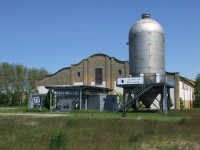Der Stummfilmprojektor "Ozaphan" ist ein Laufbildprojektor für 16 mm Kalle-Ozaphan-Filme. Seit 1932 wurde der Ozaphan-Film (Markenname für Amateurfilme) von der Chemischen Fabrik Kalle hergestellt. Ozaphan war ein Sicherheitsfilmverfahren, welches von Laien verwendet wurde, die damit ein Heimkino (u.a. "Magica") betreiben konnten.
Die Spulenkapazität für 100 m Ozaphan-Film beträgt 60 m. Das Gerät ist in einem guten Zustand.
Das Metallgehäuse ist schwarz lackiert.
Gerätenummer, neben Schalter: 58 - 03278
Antrieb: Handkurbel
Schaltwerk / Filmführung: zweiseitiger Greifer, Vorwickeltrommel und Nachwickeltrommel, zweiseitig gezahnt
Bilder / Sekunde (B/s): mit Handkurbel "1 Umdrehung für 8 Bilder"
Blende: umlaufend
Objektiv: keine Beschriftung
Beleuchtung: Lampe, Lichtweg: gerade
en

